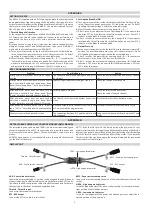
reputable accessory companies make aluminium discs and
servo arms, but you should check that the CNC machined
splines fit onto the servo output shaft tightly, with a mini-
mum of lost movement/play.
Secure the phenolic arms to the servo output discs as fol-
lows: Fit the metal discs to the servos. Centre both eleva-
tor servos using your R/C and attach the phenolic servo
arms to the outside of the metal discs temporarily with a
couple of drops of CA, making sure that the servo arms are
both at 90° to the bottom surface of the stabs using a set
square. Then remove the arms and discs, drill through
both, and secure with at least 2 small bolts, washers, lock-
nuts and Loctite (M2, 2/56 or equivalent). Finally add a drop
of Loctite to the bolt that secures the discs to the servos.
Use this same method to attach the phenolic extension
arms to metal discs for the aileron & rudder surfaces also.
At Composite-ARF we only use the aluminium ‘Double-Loc’
servo arms from SWB manufacturing (USA) and we highly
recommend them. These arms clamp onto the servo output
shaft with no lost movement (play) at all. These are high
quality, properly engineered arms, and are available from
many good hobby stores.
With your chosen servo arm secured to the servos, fit them
in place in the milled cutouts in the stabs and secure with
the 2.9 Ø x 13mm sheetmetal screws we provide.
It is
most important
that the linkage from the servo arms
is exactly in-line with the phenolic control surface horns in
the elevators, as any ‘side-load’ or ‘twisting’ could weaken
or even break them, causing flutter and destruction of your
Extra. If you have chosen to fit full metal servo arms, (eg:
SWB), you can fit a single-sided ball-link onto the servo arm to adjust the line of the linkage if
necessary - but you
must not
fit a ball-link to a phenolic or plastic servo extension arm, or phe-
nolic control surface horn.
If your chosen servo arm system does not line up perfectly with the factory-milled slots for the
phenolic control horns, you can either fill the slots and mill new ones - or even pack the servo off
the rib slightly inside the stabiliser to adjust the alignment. Make up the elevator linkages from
the hardware supplied, using M3 x 45mm threaded rods, and M3 steel clevises and nuts at both
ends. If you use a full metal servo arm, then you may need to use a wider clevise with a sepa-
rate pin and E-clip, because of the thickness of the arm and the sizes of the holes - as shown
on the SWB arms here. This also applies to the aileron horns, of course.
Control Horns
The slots for the phenolic elevator control horns are already partly milled in the elevators for you,
but may be adjusted or repositioned if required. Extend the slot for the elevator horn to least
20mm deep, using a Dremel mill or small Permagrit file, checking alignment with the linkage as
you work. Trim the length of one of the phenolic control arms so that the hole for the clevise is
Composite-ARF Extra 300SX
(2.6m span)
techsupport@composite-arf.com
16
(above) Phenolic servo arm exten-
sion bolted to metal disc on servo.
Short lengths of tube prevent cle-
vises from opening accidentally.
(below) The alternative full-metal
SWB servo arm set-up.
(above) You can ONLY use a ball-
link on a full metal servo arm to
adjust linkage alignment. Do NOT
use on phenolic arms or horns
*















































